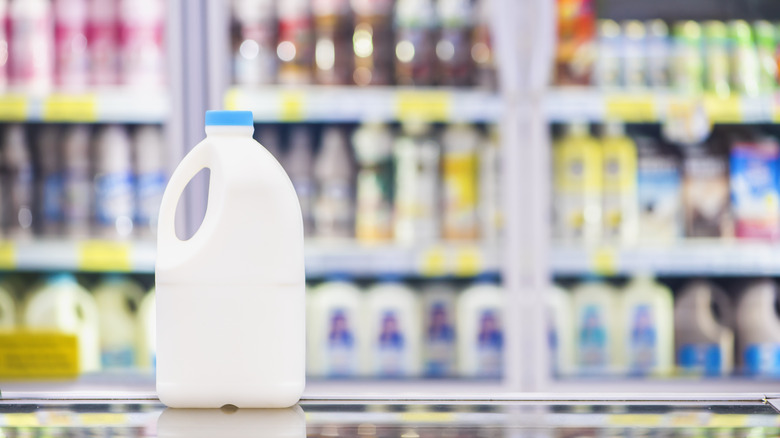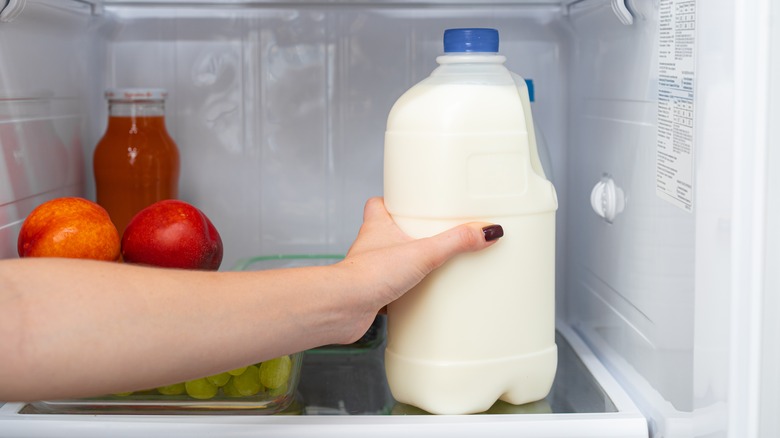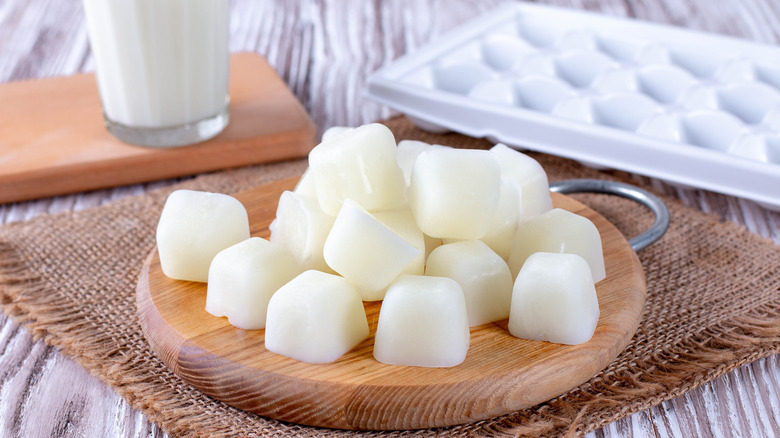The One Place In Your Fridge You Shouldn't Store Milk
There's almost nothing worse to find in your fridge than sour milk, especially if you're barely halfway through the gallon, and now you have to pour it out. To make milk last as long as possible, you might think storing it in the fridge as soon as you get home and keeping the cap screwed on tight is enough, but this isn't so. Just like there's a worst place in your fridge for storing cheese, there's also a spot where you shouldn't ever store milk: the door of your fridge.
This may come as a shock, since many of us store milk in the door area. The shelves in your fridge's door are easily accessible and may be sized perfectly to hold a milk carton, but this area undergoes temperature changes every time the fridge is opened and closed. Because the door is the warmest (or least-cold) place in the fridge, and the temperature of the door is not consistent, products stored there are more susceptible to bacterial growth. As such, milk stored here will spoil much more quickly, risking your health and wasting your hard-earned money.
Instead, store your milk in the coolest part of your fridge, typically closer to the back of any given shelf, which is where most fridges are coldest. Keep your fridge at a temperature below 40 degrees Fahrenheit, ideally closer to 37 degrees Fahrenheit, to minimize the risk of bacteria making themselves at home in your jug of milk.
How to extend the shelf life of your milk
Beyond proper storage, there are other ways to make sure you use up a carton of milk before it goes bad. For instance, keeping a jug of milk sealed until you absolutely need it can help extend its expiration date by a week. Conversely, an open jug of milk is usually only good for two to three days past its expiration date.
In addition to storing your milk in the back of the fridge and keeping it tightly sealed, you can extend milk's shelf life by minimizing its time outside of the fridge. If you're using milk for a recipe, remove the jug from the fridge only to measure out what you need, then return it to the fridge immediately afterward. Bacteria can start to grow in milk within just two hours of leaving it out of the fridge, so it's good practice to keep milk in the fridge if you aren't actively using it.
If you can't use milk right away, freeze it
Even when stored in optimal conditions, milk doesn't last forever. Typically, unopened pasteurized milk can last up to three weeks (including several days past its expiration date) in the fridge, but you can keep milk in the freezer for up to six months before quality starts to suffer.
If you choose to freeze milk, do so in a freezer-safe container. If you've got room in your freezer to stick the entire plastic jug of milk inside, that's your best option. The plastic can expand as the milk freezes, so it won't break under pressure like glass containers can. You should also follow the standard advice for freezing food in containers, and be sure to label the jug with a date so you know how long it's been in the freezer.
When you're ready to use the milk, let it thaw in the fridge as opposed to on the kitchen counter, where exposure to warmer temperatures can cause bacterial growth. Once thawed, the milk may look separated, but you can bring its components back together with a good shaking. Keep in mind that defrosted milk must be used in no more than three days, at which point it will start to spoil. Therefore, you might consider freezing milk in smaller quantities, such as in ice cube trays, so you don't have to thaw an entire jug every time.



